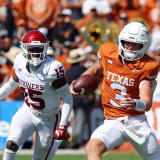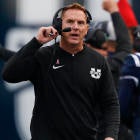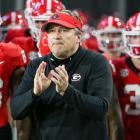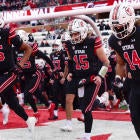The top 100 football-playing universities have to consolidate their athletic media rights to maximize their worth in the future, a powerful Oregon official told CBS Sports.
"Why? Because there's [not enough] money for athletics," Pat Kilkenny said recently. Kilkenny is a former Oregon athletic director who now consults for multiple schools and is a longtime confidant of Nike CEO Phil Knight.
"The deficits they're running on campuses isn't sustainable," he added, "… which means they have to raise the bar, which means they have to aggregate."
The model, Kilkenny said, would resemble that of the NFL, which long ago aggregated its rights and sold them to the highest bidder. Because of that model, the Packers and Patriots get the same number from networks as the Bengals and Jaguars.
That business model is considered the foundation for the NFL being one of most powerful sports entities in the world.
But asking college commissioners to go in together and share revenue might be a pipe dream. For example, Big Ten schools are averaging $50 million annually in rights fee revenue. Could it be higher if those top 100 schools were the market instead of 14 Big Ten schools negotiating on their own?
In other words, there would be no college football unless media companies negotiated with those 100 as a unit.
The 100 schools would more or less include the 65 Power Five schools, Notre Dame, the AAC, the Mountain West and selected others. There will be 130 schools in the Football Bowl Subdivision (FBS) when the 2019 season begins.
"I absolutely believe it will happen," said Kilkenny, who is also an Oregon booster and successful businessman. "It has to happen. With the digital age that we're in and the way people get their media and people like Larry Scott and Bob Bowlsby will make it happen. They're in a significant leadership role."
Kilkenny has been a long-time supporter of Scott, the Pac-12 commissioner. His relationship with Bowlsby goes back to when the current Big 12 commissioner was AD at Stanford.
Bowlsby indicated any sort of change to the current structure would be far into the future. The Big 12 just announced a lucrative bridge deal with ESPN that makes the league the first Power Five conference to sell content to the company's ESPN+ digital platform.
Through a spokesman, Scott had no comment.
"Smart, visionary leaders will figure those things out," Kilkenny said, "but you do have to get the NCAA out of the way."
Kilkenny, 67, remains an influential figure in college athletics, especially on the West Coast. He was Oregon's AD from 2006-09, during which time he secured a $100 million donation from Knight for Oregon's current basketball arena. He also is responsible for reinstating baseball after 28 years.
"Conferences can't even agree on the number of conference games to play, how can they agree on [the number of schools forming their own negotiating unit]?" Kilkenny said. "That's why I think it's going to be a bigger number. One hundred universities will get together."
It has long been speculated the top football-playing schools could leave the NCAA and form their own association. Notre Dame AD Jack Swarbrick told CBS Sports that similar lines could be drawn over player compensation.
Kilkenny's assertion has more to do with finances and negotiating leverage. The College Football Association attempted to do just that. The organization existed from the late 1970s to 1992, seeking schools' rights to televise their games.
After schools won that right in 1984, the CFA eventually broke up. With the NCAA no longer controlling television rights, schools and conferences signed their own media rights deals.
Under Kilkenny's plan, things could come full circle. A media giant, such as Facebook or Apple, could theoretically buy the 100-school unit if either decides to get into live sports content.
Currently, only a handful of athletic departments make money. The financial -- even physical -- gap between Power Five programs and Group of Five programs is increasing and has now subdivided. Even within the Power Five, schools have less of a chance competing with those at the top. (See: Alabama and Clemson separating themselves from the rest of FBS football.)
If that dominance continues, Kilkenny said, "then it becomes 10 or 12 schools that can compete. That's why they have to aggregate."
Even with schools making record revenue via media rights deals, that money is usually accounted for … to the penny. In general, football produces the revenue that pays for money-losing minor sports.
The business model gets out of whack when the NCAA mandates schools sponsor at least 14 sports. That, combined with debt service being paid on existing facilities, might be the biggest drag on Power Five finances.
It has been speculated for years that, with mounting financial pressures, the NCAA does away with those sports-sponsorship minimums. Some minor sports would continue but only at the club level without school support.
Some schools are already exploring unique ways to save money: Schools are considering playing sports like track and volleyball only on regional schedules.
Kilkenny called the current structure "a disinvestment in higher education."
Kilkenny is currently chief executive officer of K2 Insurance Services. A San Diego resident, he also is on the advisory boards of San Diego State and California-San Diego.
















